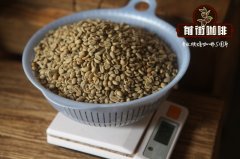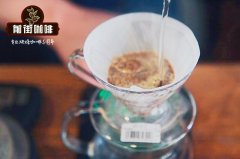How does Malaba form the flavor of Indian coffee?

Coffee was brought into the establishment of the first coffee farm by pilgrims as early as the 16th century, and you might not have imagined that India produces much more coffee than Ethiopia and any Central American country, with 900000 hectares of land growing coffee beans. There are about 140000 coffee farms in India. More than 90% of the farms cover an area of less than 10 mu for small-scale farming. These farms are distributed in the coastal mountains of 900 to 1200 meters in the south and east. Arabica accounts for two-thirds of the coffee varieties, and the rest is Robsta species, with a total output of about 44-450000 bags, making it the fifth largest coffee producer in the world.
When it comes to Malabar, the most common wind stain in Indian coffee, the main reason is that in ancient times, coffee took months to arrive in Europe. During the voyage, due to exposure to salt-filled sea breeze and moisture, the coffee beans changed a special taste, and the original fresh dark green coffee beans also became yellowish brown with Mantenin. At that time, Europeans liked the rich thickness and peculiar flavor, and today coffee farmers are beginning to find ways to replicate it. It took them six weeks to expose their coffee to the monsoon monsoon season from May to June, when the southwest breeze was strongest, so it was also known as the monsoon Malaba, which made the coffee look a little aged like an aged manning, with a unique taste with a strong pickled flavor. As for the evaluation, there is a big difference.
Indian coffee is harvested from November to March of the following year. In 2010, we introduced Yelnoorkhan Estate Farm (Yelnoorkhan Estate), a Baba Budan producing area in western India at an altitude of 6000 feet above sea level. Alecon Farm has rich natural ecology. Coffee grows in shaded and fertile soil. There are many species on the farm of 1450 acres, most of which are Kent trees (which are derived from Arabica). Moreover, it is the most primitive and naturally grown coffee farm in India over the past decade, and it is also the most famous area in India for producing sun beans, which is very different from the monsoon beans on the southern and eastern coastal mountains mentioned above, with much more complex aroma and taste.

Indian sun-dried beans and Haramoka sun-dried beans
The beans are similar in shape, same size and little difference in color, but about 4% of the yellowish brown overfermented beans are found in Indian sun beans.
Shallow roasting end of explosion (City): in shallow roasting, the dry aroma of ground coffee has a strong grape fruit aroma, the brewed sun beans have the unique fermentation flavor of guava, the taste of thin fermented tea is heavy, the acidity of grapefruit is a little low, the fruit of tomato guava is sweet, and the sweetness of Yuyun sweet oolong tea is equal to tea.
Re-baking start (Full City): 1 minute after the first explosion is the heaviest baking degree of Alecon sun-dried beans, the aroma of coffee after grinding seems to add beer to chocolate, this mixed aroma is very special, which is unique to other sun-dried beans in India, with a hint of star anise and licorice after brewing, and the sweetness of tropical fruit banana guava with a rich and smooth tea taste. In the sweetness of sugarcane brown sugar, Yuyun can vaguely smell the aroma of grapefruit wrapped tea.
Important Notice :
前街咖啡 FrontStreet Coffee has moved to new addredd:
FrontStreet Coffee Address: 315,Donghua East Road,GuangZhou
Tel:020 38364473
- Prev

Yemeni mocha coffee Shannani features introduction to introduce you to Yemeni coffee
Country: Yemen production area: Shannani Farm name: small producing group grade: naturally dried Arabica beans, no regulatory agency, no grading system altitude: 1650 meters certification: all coffee is grown organically in accordance with the ancient method, without the use of pesticides containing chemicals, etc. Varieties: 10 special local native mocha species to Jaadi,Taffahi, Dawa
- Next

Ethiopian Coffee | what is the flavor of the washed coffee in the black plaid skirt treatment field in Yega Xuefei area?
The black plaid skirt processing field in the Yejashafi producing area is located in the famous Yesuela producing area in Ethiopia. About 500 farmers hand over their coffee beans to the black plaid skirt cleaning station. Small farmers cultivate about 2.5 hectares, which is between 1850 and 1900 meters above sea level. Farmers must send the harvested coffee to the treatment plant immediately. If it takes more than 4 hours, the coffee will ferment.
Related
- Detailed explanation of Jadeite planting Land in Panamanian Jadeite Manor introduction to the grading system of Jadeite competitive bidding, Red bid, Green bid and Rose Summer
- Story of Coffee planting in Brenka region of Costa Rica Stonehenge Manor anaerobic heavy honey treatment of flavor mouth
- What's on the barrel of Blue Mountain Coffee beans?
- Can American coffee also pull flowers? How to use hot American style to pull out a good-looking pattern?
- Can you make a cold extract with coffee beans? What is the right proportion for cold-extracted coffee formula?
- Indonesian PWN Gold Mandrine Coffee Origin Features Flavor How to Chong? Mandolin coffee is American.
- A brief introduction to the flavor characteristics of Brazilian yellow bourbon coffee beans
- What is the effect of different water quality on the flavor of cold-extracted coffee? What kind of water is best for brewing coffee?
- Why do you think of Rose Summer whenever you mention Panamanian coffee?
- Introduction to the characteristics of authentic blue mountain coffee bean producing areas? What is the CIB Coffee Authority in Jamaica?

